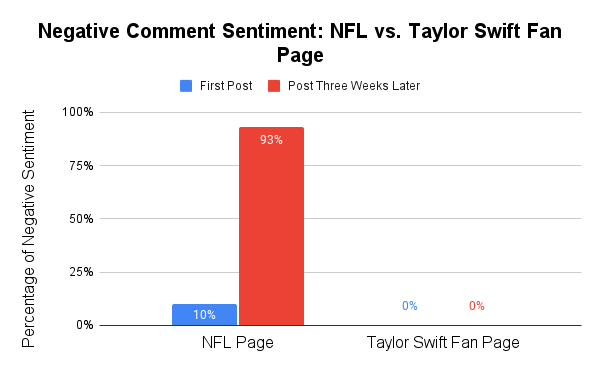Is the Evermore singer evergreen? It depends on who’s posting.
In today’s digital world, creating content that resonates with your audience is more than just a marketing strategy—it’s a way to foster kindness and positive dialogue online.
To do this, you need to tailor your message to your audience by balancing the type and the frequency of your posts.
There are two main types of content:
- Evergreen content, as the name suggests, is content that remains relevant and useful, regardless of when it was published.
- Timely content is content that is time-bound and usually revolves around current events, trending stories, holidays, or breaking news.
While it’s important to incorporate both types of content, the frequency of each will depend on your purpose and audience. Posting too much of either type of content can lead to issue fatigue, irritating your audience and resulting in negative comments.
This article will equip you—whether you’re a business, individual, or both—with strategies to better connect with your audience and, consequently, minimize the amount of negative comments you receive online.
The Importance of Audience Tailoring: A Taylor Swift Case Study
The NFL’s coverage of Taylor Swift’s budding romance with Travis Kelce shows what happens when a page fails to tailor its message to its audience.
When Taylor Swift first showed up at a Chiefs game, the NFL posted about her attendance across social media platforms. As illustrated by the chart below, the overall sentiment of the first 30 comments1 on the NFL’s first post was positive2 or neutral—only 10% of sampled comments exhibited annoyance, irritation, or rude speech.3
Fast forward nearly 3 weeks and 12 Taylor Swift posts later, and the comments section grew hostile toward the singer and even the NFL itself. On the NFL’s thirteenth post, 93% of comments were rude or hateful. That’s an 830% increase in mean comments compared with the NFL’s first post. NFL fans are clearly experiencing extreme issue fatigue and are responding negatively as a result.
The problem is that the NFL is treating what should be timely content as evergreen content by giving Taylor Swift a prominent place in its social media feed when followers want—and expect—to see football updates, not celebrity gossip.
In contrast, a Taylor Swift fan page saw no change in negative sentiment between its 1st post about her attending a Chiefs game to its 28th post three weeks later. There was no negativity in any of the sampled comments from either post.

This goes to show that it is okay to repeatedly post timely content as long as it fits with your page and what your audience is expecting to see. In this case, timely content can also become evergreen content.
On the other hand, when the content you share deviates from your followers’ expectations in terms of type or frequency, the risk of encountering negative, even hateful, comments greatly increases.
The Importance of Listening: A Jada Pinkett Smith Case Study
Even when your content is aligned with your audience’s expectations, it’s still important to listen to the feedback you’re receiving and make changes accordingly.
Consider the following example. People Magazine claims to be “The #1 source for celebrity news,” so frequent, timely posts about the latest celebrity drama are exactly what followers are expecting from its page.
However, People’s initial Instagram post about Jada Pinkett Smith’s new memoir was met with immediate annoyance and discontent from its followers with more than half commenting that they didn’t care and didn’t want to see any more.
Despite this, People went on to post 12 more times about Jada. The comments on the 13th post shifted from attacking the content to attacking People itself, with 63% of sampled comments expressing frustration and anger toward People’s writers. One commenter even went as far as to say, “Listen to your readers. We are all over it. Stop.”
Even though People was posting content that was in line with their purpose, they not only failed to listen to their followers, but they severely overdid it by posting 12 unwanted posts on the same unwanted topic. As a result, the online discourse grew more aggressive and hateful.
Recap
To wrap up, here are a few of the most important things to remember to keep your audience engaged with your content, and more importantly, to keep the comments section civil:
- Know your audience and tailor your messages to them. Take the time to understand your followers’ interests, demographics, and online behavior. This will help you create content that resonates with them and keeps them coming back for more.
- Understand the importance of balancing evergreen and timely content. Evergreen content is always relevant and can be shared repeatedly, while timely content is specific to a current event or trend. A healthy mix of both types of content will keep your audience engaged and informed.
- Listen to your followers and make adjustments when necessary. Pay attention to the comments your followers leave on your posts. This will give you valuable insights into what they like and don’t like. Be willing to experiment with different types of content and adjust your strategy accordingly.
- Don’t overdo it! Don’t bombard your followers with too much content. Quality over quantity is always the best approach.
Try these strategies out and share your experiences in the comments section below. We’d love to hear how they’ve worked for you!
-Liberty Howell, Netiquette
Methodology Notes:
130 comments was used as the standard sample size for all posts referenced in this article. The first 30 comments posted on each post were selected in place of a random sample of 30 comments to avoid selecting comments that were posted retrospectively and thus not accurately reflecting the effects of time and frequency on sentiment.
2Positive comments in this article are defined as any comment that projects a positive sentiment regarding the post content. Such comments typically include heart emojis and smiley faces, encouraging speech, and polite dialog. If there was any question as to whether or not a comment was positive, I labeled it as neutral.
3Negative comments in this article are defined as any comment that projects a negative sentiment regarding the post content, including thumbs-down emojis or frowny faces, angry speech, annoyed comments, and mean or sarcastic dialog. If there was any question as to whether or not a comment was negative, I labeled it as neutral.
FEATURE IMAGE BY LARRY KOESTER
Learn More
Learn more about how you can avoid “overdoing it” by reading How Frequent is Too Frequent to Post on Social Media?





Sean Rausch
This is an excellent article! I love the message of the type and frequency of the message and I can see how impactful and important those two things are. The writing was clear and easy to read and is full of interesting and useful information applicable to anyone business or individual. Great job!